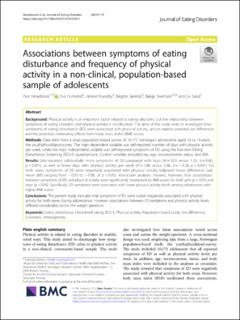| dc.contributor.author | Heradstveit, Ove | |
| dc.contributor.author | Holmelid, Eva | |
| dc.contributor.author | Klundby, Helene | |
| dc.contributor.author | Søreide, Birgitte | |
| dc.contributor.author | Sivertsen, Børge | |
| dc.contributor.author | Sand, Liv | |
| dc.date.accessioned | 2020-03-23T09:24:42Z | |
| dc.date.available | 2020-03-23T09:24:42Z | |
| dc.date.created | 2019-05-28T10:38:49Z | |
| dc.date.issued | 2019-04 | |
| dc.identifier.citation | Heradstveit, O., Holmelid, E., Klundby, H. et al. (2019) Associations between symptoms of eating disturbance and frequency of physical activity in a non-clinical, population-based sample of adolescentsJournal of Eating Disorders, 7. | en_US |
| dc.identifier.issn | 2050-2974 | |
| dc.identifier.uri | https://hdl.handle.net/11250/2648026 | |
| dc.description.abstract | Background
Physical activity is an important factor related to eating disorders, but the relationship between symptoms of eating disorders and physical activity is multifaceted. The aims of this study were to investigate how symptoms of eating disturbance (ED) were associated with physical activity, and to explore potential sex differences and the potential moderating effects from body mass index (BMI) scores.
Methods
Data stem from a large population-based survey of 10,172 Norwegian adolescents aged 16 to 19 years, the youth@hordaland-survey. The main dependent variable was self-reported number of days with physical activity per week, while the main independent variable was self-reported symptoms of ED using the five-item Eating Disturbance Screening (EDS-5) questionnaire. Control variables included sex, age, socioeconomic status, and BMI.
Results
Girls reported substantially more symptoms of ED compared with boys (M = 3.02 versus 1.32, d = 0.80, p < 0.001), as well as fewer days with physical activity per week (M = 2.88 versus 3.46, d = − 0.28, p < 0.001). For both sexes, symptoms of ED were negatively associated with physical activity (adjusted mean differences (adj. mean diff) ranging from − 0.03 to − 0.08, all p < 0.05). Interaction analyses showed, however, that associations between symptoms of ED and physical activity were significantly moderated by BMI scores for both girls (p < 0.01) and boys (p < 0.05). Specifically, ED symptoms were associated with lower physical activity levels among adolescents with higher BMI scores.
Conclusions
The present study indicates that symptoms of ED were overall negatively associated with physical activity for both sexes during adolescence. However, associations between ED symptoms and physical activity levels differed considerably across the weight spectrum. | en_US |
| dc.language.iso | eng | en_US |
| dc.publisher | BioMed Central | en_US |
| dc.rights | Navngivelse 4.0 Internasjonal | * |
| dc.rights.uri | http://creativecommons.org/licenses/by/4.0/deed.no | * |
| dc.subject | spiseforsyrrelser | en_US |
| dc.subject | fysisk aktivitet | en_US |
| dc.title | Associations between symptoms of eating disturbance and frequency of physical activity in a non-clinical, population-based sample of adolescents | en_US |
| dc.type | Journal article | en_US |
| dc.type | Peer reviewed | en_US |
| dc.description.version | publishedVersion | en_US |
| dc.rights.holder | © The Author(s). 2019 | en_US |
| dc.subject.nsi | VDP::Medical disciplines: 700::Clinical medical disciplines: 750 | en_US |
| dc.source.pagenumber | 9 | en_US |
| dc.source.volume | 7 | en_US |
| dc.source.journal | Journal of Eating Disorders | en_US |
| dc.identifier.doi | 10.1186/s40337-019-0239-1 | |
| dc.identifier.cristin | 1700771 | |
| cristin.unitcode | 217,13,0,0 | |
| cristin.unitname | Det helsevitenskapelige fakultet | |
| cristin.ispublished | true | |
| cristin.fulltext | original | |
| cristin.qualitycode | 1 | |

